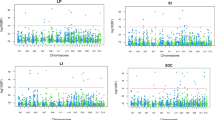Abstract
Use of cross incompatibility in corn (Zea mays L.) by the Ga1-s allele may reduce cross-fertilization in specialty and conventional organic corn with pollen from genetically-modified (GM) corn. For effective use, information about environment, and genotype × environment effects on cross-fertilization by ga1 as well as heritability of cross incompatibility in maize is necessary. Our objective was to obtain this information. Four population pairs differing in their genotype at ga1 were evaluated for cross incompatibility with ga1 pollen in different environments. Populations were derived by crossing the recurrent parents B116, PHG35, ARZM16035:S19, and (CHZM05015:Mo17)Mo17 to Ga1-s donor parent Mo508W/Mo506W. Two replicates of each treatment were grown in the center of 952 m2 fields planted with purple corn as an adventitious source of ga1/ga1 pollen. Open pollination was allowed and the amount of cross-fertilization estimated by averaging the percentage of purple seeds. Environment and genotype × environment effects were not significant. Contrasts to evaluate differences in cross-fertilization between Ga1-s and ga1 populations revealed that mean percentages of cross-fertilization in Ga1-s populations of B116, ARZM16035:S19, and (CHZM05015:Mo17)Mo17 were significantly lower than in ga1 populations. The estimated broad-sense heritability on an entry-mean basis for cross incompatibility was 0.81. Results suggest differences in genotype at ga1 played a major role in cross-fertilization of populations differing in their genotype at the ga1 locus. Incompatibility may be selected effectively over different environments and the Ga1-s system may be of value to reduce cross-fertilization with GM corn pollen.


Similar content being viewed by others
References
De la Cruz L, Sánchez J, Ron J, Santacruz F, Baltazar B, Ruíz JA, Morales MM (2008) El factor gametofítico-1 (ga1) en híbridos comerciales de maíz de México. Rev Fitotec Mex 31:57–65
Demerec M (1929) Cross incompatibility in maize. Z Indukt Abstamm Vererb 50:281–291
Devos Y, Reheul D, De Schrijver A (2005) The co-existence between transgenic and non-transgenic maize in the European Union: a focus on pollen flow and cross-fertilization. Environ Biosaf Res 4:71–87
Emerson RA (1934) Relation of the differential fertilization genes, Ga ga, to certain other genes of the Su–Tu linkage group in maize. Genetics 19:137–156
Evans MMS, Kermicle JL (2001) Teosinte crossing barrier1, a locus governing hybridization of teosinte with maize. Theor Appl Genet 103:259–265
Fehr WR (1991) Principles of cultivar development. Macmillan Publishing Company, New York
Goggi AS, Caragea P, Lopez-Sanchez H, Westgate M, Arritt R, Clark C (2006) Statistical analysis of cross-fertilization between adjacent maize grain production fields. Field Crop Res 99:147–157
Goggi AS, Lopez-Sanchez H, Caragea P, Westgate M, Arritt R, Clark CA (2007) Gene flow in maize fields with different local pollen densities. Int J Biometeorol 51:493–503
Hallauer AR, Lamkey KR, White PR (2004) Registration of B116 inbred line of maize. Crop Sci 44:703
Jaradat AA, Goldstein W, Dashiell K (2010) Phenotypic structures and breeding value of open-pollinated corn varietal hybrids. Int J Plant Breed 4:37–46
Kermicle JL (2006) A selfish gene governing pollen-pistil compatibility confers reproductive isolation between maize relatives. Genetics 172:499–506
Kermicle JL, Allen JO (1990) Cross incompatibility between maize and teosinte. Maydica 35:399–408
Kermicle JL, Evans MMS (2010) The Zea mays sexual compatibility gene ga2: naturally occurring alleles, their distribution, and role in reproductive isolation. J Hered 101(6):737–749
Kermicle JL, Taba S, Evans MMS (2006) The gametophyte-1 locus and reproductive isolation among Zea mays subspecies. Maydica 51:219–225
Lausser A, Kliwer I, Srilunchang K, Dresselhaus T (2010) Sporophytic control of pollen tube growth and guidance in maize. J Exp Bot 61:673–682
Maletzky SI, Siritza BN (1972) Effect of pollination condition on the expression of the gametophyte locus of chromosome 4. Maize Genet Coop Newsl 46:66–68
Mangelsdorf PC, Jones DF (1926) The expression of Mendelian factors in the gametophyte of maize. Genetics 11:423–455
Nelson OE (1952) Non-reciprocal cross incompatibility in maize. Genetics 37:101–124
Nelson OE (1993) The gametophyte factors of maize. In: Freeling M, Walbot V (eds) The maize handbook. Springer, New York, pp 496–503
Neuffer MG, Coe EH, Wessler SR (1997) Mutants of maize. Cold Spring Harbor Laboratory Press, New York
Perry HS (1945) The Ga gene as a means of reducing contamination of sweetcorn. J Hered 36:131–134
Pollak LM (2003) The history and success of the public-private project on germplasm enhancement of maize (GEM). Adv Agron 78:45–87
Poneleit CG (2001) Breeding white endosperm corn. In: Hallauer AR (ed) Specialty corns, 2nd edn. CRC Press, Florida, pp 235–274
Roseboro K (2008) Experts dispute patent on gene-blocking corn. The Organic & Non-GMO Report, Fairfield
SAS Institute (2008) SAS Version 9.2. SAS Inst, Cary
Schwartz D (1950) The analysis of a case of cross incompatibility in maize. Proc Nat Acad Sci USA 36:719–724
Thomas WI (1955) Transferring the gas factor for dent-incompatibility to dent-compatible lines of popcorn. Agron J 47:440–441
Whiteley JR (1953) Cross incompatibility in maize. Dissertation, Iowa State College
Ziegler KE, Ashman B (2001) Popcorn. In: Hallauer AR (ed) Specialty Corns, 2nd edn. CRC Press, Florida, pp 199–234
Acknowledgments
We thank Dr. Walter Goldstein (Michael Fields Agricultural Institute) and the GEM project for providing the plant materials used in this study. We also thank Dr. Silvia Cianzio for helpful comments on the manuscript, and John Golden, Tina Paque, and Alan Gaul for technical assistance.
Author information
Authors and Affiliations
Corresponding author
Rights and permissions
About this article
Cite this article
González, M.D., Pollak, L.M. & Goggi, A.S. Genotype × environment interactions in populations possessing Ga1-s and ga1 alleles for cross incompatibility in maize. Euphytica 185, 377–384 (2012). https://doi.org/10.1007/s10681-011-0543-6
Received:
Accepted:
Published:
Issue Date:
DOI: https://doi.org/10.1007/s10681-011-0543-6




